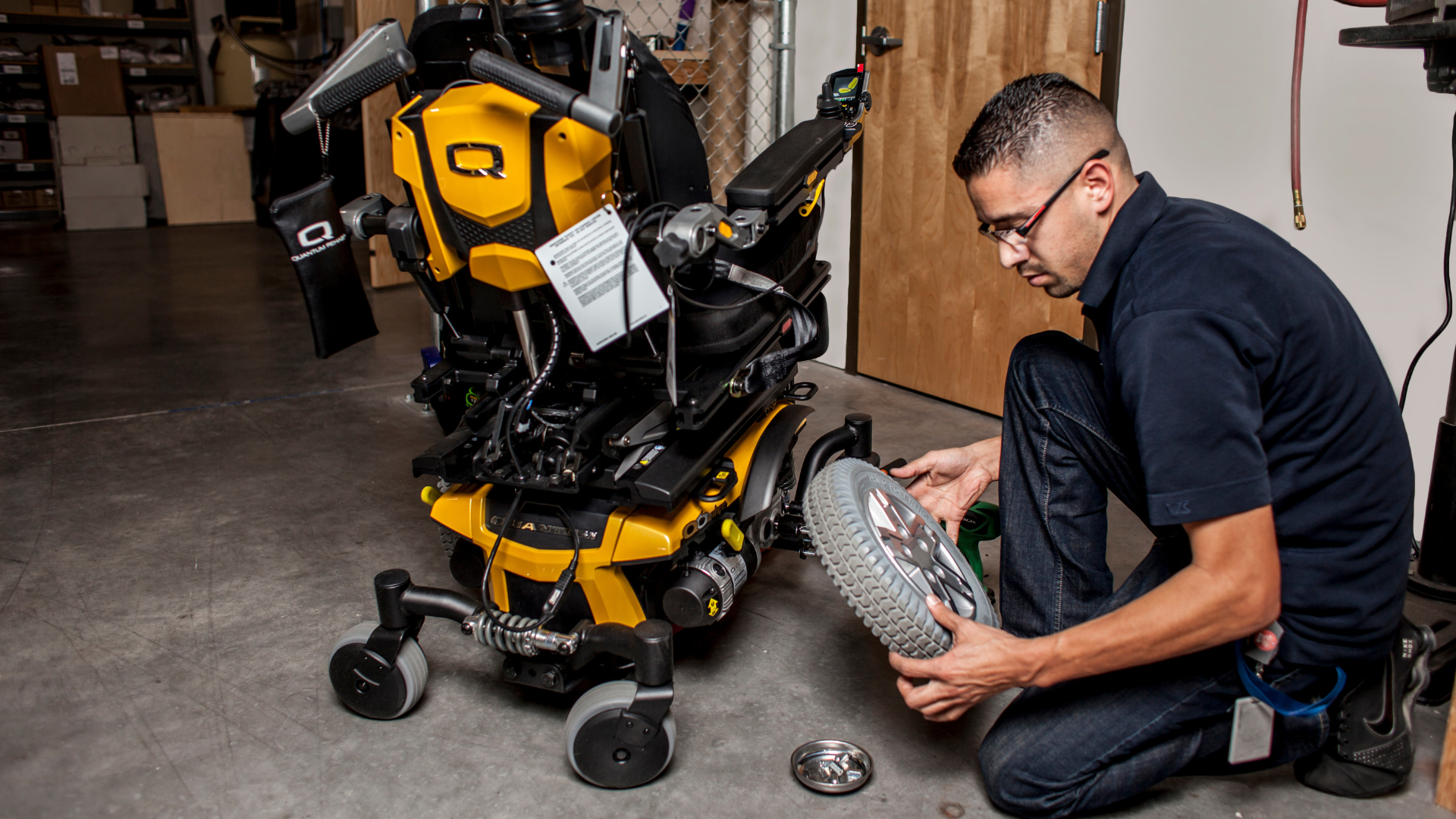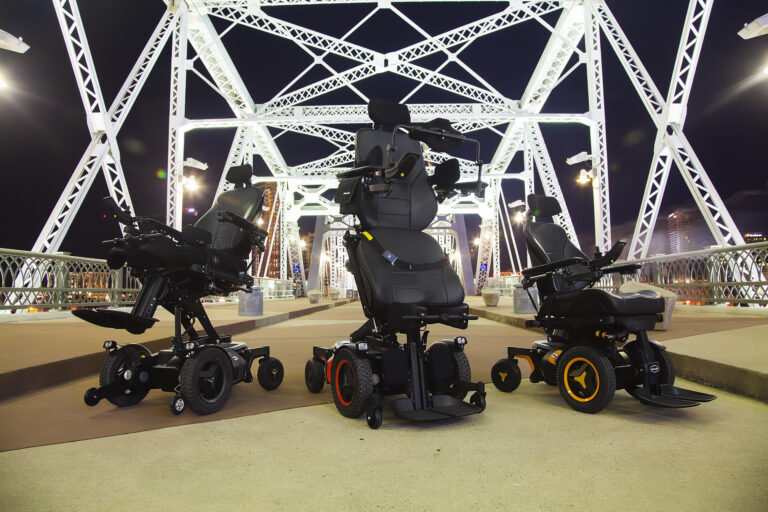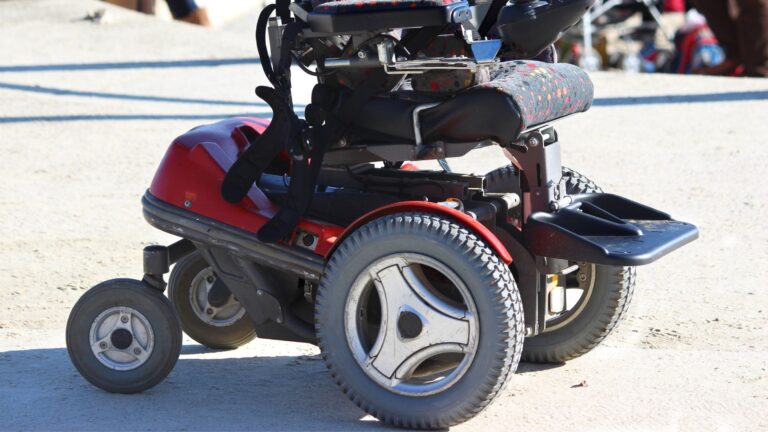During an evaluation for a power wheelchair, the wheelchair prescription team of the doctor, the therapist and the assistive technology professional must fully evaluate a client’s needs.
Thorough review of environment, circumstances, and activities of daily living must take place to facilitate providing an optimal mobility device. Seating and positioning components recommendations are generally guided by a client’s physical presentation and functional abilities. A mobility base is much more subjective – the team, including the client, must consider the context of the environments that are encountered most, lower extremity positioning needs, drive control access and the client’s likely weight distribution relative to the drive wheels and casters. With new users, one needs to consider the client’s cognitive and perceptual-motor abilities and their effects on learning. Let’s examine the pros and cons of each drive wheel configuration.
Rear-Wheel Drive Base
On a rear-wheel drive base, the drive wheels are in the rear, there are two large casters in the front, and two small anti-tip wheels behind the drive wheel for safety. Generally speaking, rear- wheel drive power wheelchairs have excellent tracking at higher speeds, typically have good suspensions, and have highest ground clearance. Unfortunately, while they are considered to excel at outdoor mobility, they have some limitations when it comes to confined spaces. The rear-wheel drive base maneuvers like a car with the front casters initiating turns. Therefore, the turning radius is the largest of the three drive wheel configurations. Due to the large front casters needing room to turn, the lower extremities of the user must be positioned in front of the casters. This position may be problematic for users with tight hamstrings. Having the feet beyond the front casters not only increases the turning radius, but it also limits weight distribution, as the body must be positioned far enough forward to clear the casters. This may increase the load on the casters, making turns more difficult to initiate and turns more “jerky” and it may unweight the drive wheels, resulting in loss of traction, especially with heavier individuals (Holliday, Mihailidis, Rolfson, & Fernie, 2005; Morgan & Kerr, 2013; Radabaugh, 2018).
Front-Wheel Drive Base
A front-wheel drive base has the drive wheels in the front, two large casters in the rear, and sometimes, two small anti-tip wheels in front of the drive wheel. Front-wheel drive power wheelchairs meet obstacles with the drive wheel and are able to climb with less impact on the user. However, the presence of front anti-tips may decrease clearance. Front-wheel drive wheelchairs allow for optimal lower extremity positioning, especially for those clients who have tight hamstrings. Along the same lines, when transfers require the user to be close to surfaces, the lack of front casters allows users to potentially get closest to destinations of the drive wheel configurations. Because front-wheel drive wheelchairs pull rather than push the wheelchair, they tend to handle better on softer terrain than rear-wheel or mid-wheel drive. Weight distribution tends to be over the drive wheels which is advantageous especially with heavier individuals, although if the weight distribution is too far forward, it may become “tippy.” With the forward weight distribution, tracking at high speeds may be more challenging as the rear casters may not have enough weight, causing some “flutter,” which may present a steering challenge especially at high speeds (Koontz, Brindle, Kankipati, Feathers, & Cooper, 2010; Morgan & Kerr, 2013; Radabaugh, 2018).
Mid-Wheel Drive Base
Mid-wheel drive power wheelchairs have a centered drive wheel with two front casters and two rear casters. Because of the wheel placements, this base tends to be the most stable of all of the bases and because the drive wheel is in the center, they are able to “turn on a dime.” They have good control at high speeds and on side-sloping surfaces, similar to the rear-wheel drive. They have the lowest turning radius and may be the most intuitive to drive. Also, when using a switch drive (such as a head array or sip-and-puff) rather than a standard joystick, users may find it less labor-intensive with fewer maneuvers required in small spaces. The mid-wheel drive may have the lowest ground clearance and are the most at-risk to “high center,” especially on rough terrain. The front swiveling casters may limit lower extremity positioning, but the mid-wheel drive can usually accommodate tight hamstrings as long as the feet can be supported in the middle of the body with a center-mounted foot plate (Dolan, Bolton, & Henderson, 2017; Holliday et al., 2005; Koontz et al., 2010; Morgan & Kerr, 2013; Radabaugh, 2018).
Aside from personal preference and context, one may consider the general maneuvering of the power wheelchair for safety and access. Please note that this final commentary is for clinical considerations, and to encourage trials, rather than a guide to follow.
Additional Clinical Considerations
- Front-wheel drive power wheelchairs may allow for a power standing function in conjunction with the ability to drive.
- Front-wheel drive power wheelchairs may require the least amount of space for an L-shaped turn, especially for bathroom or kitchen access.
- Mid-wheel drive wheelchairs require the least space for a turn-in-place maneuver.
- Front- and mid-wheel drive wheelchairs are generally better for maneuvering in confined spaces.
- Mid-wheel drive power wheelchairs are likely the more intuitive to learn for new users and those who have impaired proprioception as turns are initiated closer to the bend.
- For users that have safety concerns with driving, especially pediatric clients in schools, rear- or mid-wheel drive may be considered as L-turns are initiated further away (toward center of hallway) from doorways and blind corners.

author
Alexis Rush
OTR/L, ATP
Alexis Rush is an Assistive Technology Professional specializing in equipment for persons with spinal cord and brain injuries. She graduated from Xavier University with a degree in occupational therapy in 2003 and has her Doctor of Occupational Therapy from the University of St. Augustine. As a therapist, Alexis specialized in acute adult neurologic injury but also worked as a pediatric home health occupational therapist. She now works as a wheelchair provider at a large rehabilitation hospital in Denver, Colorado. Alexis is a mountain sports lover and an avid world explorer.
References
Dolan, M. J., Bolton, M. J., & Henderson, G. I. (2017). Comparison of seating, powered characteristics and functions and costs of electrically powered wheelchairs in a general population of users. Disability and Rehabilitation: Assistive Technology, 1-6. https://doi.org/10.1080/17483107.2017.1393701
Holliday, P. J., Mihailidis, A., Rolfson, R., & Fernie, G. (2005). Understanding and measuring powered wheelchair mobility and manoeuvrability. Part I. Reach in confined spaces. Disability and Rehabilitation, 27(16), 939-949.
Koontz, A. M., Brindle, E. D., Kankipati, P., Feathers, D., & Cooper, R. A. (2010). Design features that affect the maneuverability of wheelchairs and scooters. Archives of Physical Medicine and Rehabilitation, 91(5), 759-764.
Morgan, A & Kerr, M. (24 February, 2013). Clinical Applications for Power Wheelchair Platforms. [Continuing education course lecture notes]. Clinical Education Division, Permobil, Lebanon, TN.
Radabaugh, J.B. (22 August, 2018). The Power of Choice. [Continuing education course lecture notes]. Clinical Education Division, Pride/Quantum Rehab, Exeter, PA.



